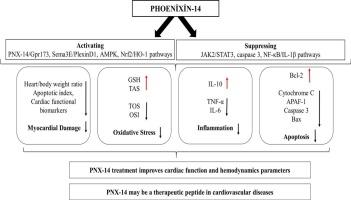Cardioprotective role of phoenixin-14 in isoproterenol-induced myocardial injury: Involvement of AMPK, JAK2/STAT3, and Sema3E pathways
IF 5.1
2区 医学
Q1 MEDICINE, RESEARCH & EXPERIMENTAL
引用次数: 0
Abstract
Aims
This study aimed to evaluate the cardioprotective effects of phoenixin-14 (PNX-14) in isoproterenol (ISO)-induced myocardial infarction (MI) in rats, comparing both preventive and therapeutic administration.
Materials and methods
Seventy adult male Wistar rats were divided into five groups: Control, PNX-14, ISO, ISO + PNX-14 (PNX-14 treatment after ISO), and PNX-14 + ISO (PNX-14 pretreatment before ISO). MI was induced by subcutaneous ISO (100 mg/kg/day) for two days. PNX-14 (5 nmol/kg, intraperitoneally) was administered once daily for 3 days. Biochemical, molecular, and histopathological analyses were performed to evaluate oxidative stress, inflammatory response, and apoptosis in cardiac tissue.
Key findings
PNX-14 treatment significantly reduced the ISO-induced increases in heart/body weight ratio (0.54 ± 0.05), infarct size (47.3 ± 2.51 %), apoptotic index (40.8 ± 2.99 %), and cardiac necrosis markers CK-MB and TnI (p < 0.001). It improved antioxidant defenses by increasing glutathione (GSH) and total antioxidant status (TAS), while reducing total oxidant status (TOS) and oxidative stress index (OSI). Pro-inflammatory cytokines TNF-α and IL-6 were lowered, and anti-inflammatory IL-10 increased. PNX-14 also attenuated apoptosis in cardiac tissue by downregulating cytochrome c, APAF-1, caspase-3, and Bax, and upregulating the anti-apoptotic marker Bcl-2. These effects were linked to modulation of Gpr173, AMPK/Nrf2/HO-1, and Sema3E/PlexinD1 pathways, alongside suppression of JAK2/STAT3 and NF-κB signaling. Furthermore, PNX-14 improved hemodynamic stability and histopathologically reduced ISO-induced myocardial damage.
Significance
These results demonstrate that PNX-14, particularly when administered after injury, effectively attenuates myocardial damage through multi-pathway regulation of oxidative stress, inflammation, and apoptosis. PNX-14 may hold therapeutic potential for the prevention and treatment of cardiovascular diseases.

凤凰素-14在异丙肾上腺素诱导的心肌损伤中的心脏保护作用:AMPK、JAK2/STAT3和Sema3E通路的参与
目的:研究凤凰素-14 (PNX-14)对异丙肾上腺素(ISO)致心肌梗死(MI)大鼠的心脏保护作用,并比较其预防和治疗作用。材料与方法:70只成年雄性Wistar大鼠分为5组:对照组、PNX-14、ISO、ISO + PNX-14 (ISO后PNX-14处理)和PNX-14 + ISO (ISO前PNX-14预处理)。皮下注射ISO(100 mg/kg/day)诱导心肌梗死2天。PNX-14(5 nmol/kg,腹腔注射)每日1次,连用3 天。通过生化、分子和组织病理学分析来评估心脏组织中的氧化应激、炎症反应和细胞凋亡。重要发现:PNX-14治疗显著降低ISO-induced增加心脏/体重比(0.54 ±0.05 ),梗死大小(47.3 ±2.51 %),凋亡指数(40.8 ±2.99 %),和心肌坏死标志物水平和交通噪音指数(p 意义:这些结果说明PNX-14,尤其是当管理受伤后,通过multi-pathway监管有效减弱心肌损伤的氧化应激,炎症和细胞凋亡。PNX-14可能具有预防和治疗心血管疾病的治疗潜力。
本文章由计算机程序翻译,如有差异,请以英文原文为准。
求助全文
约1分钟内获得全文
求助全文
来源期刊

Life sciences
医学-药学
CiteScore
12.20
自引率
1.60%
发文量
841
审稿时长
6 months
期刊介绍:
Life Sciences is an international journal publishing articles that emphasize the molecular, cellular, and functional basis of therapy. The journal emphasizes the understanding of mechanism that is relevant to all aspects of human disease and translation to patients. All articles are rigorously reviewed.
The Journal favors publication of full-length papers where modern scientific technologies are used to explain molecular, cellular and physiological mechanisms. Articles that merely report observations are rarely accepted. Recommendations from the Declaration of Helsinki or NIH guidelines for care and use of laboratory animals must be adhered to. Articles should be written at a level accessible to readers who are non-specialists in the topic of the article themselves, but who are interested in the research. The Journal welcomes reviews on topics of wide interest to investigators in the life sciences. We particularly encourage submission of brief, focused reviews containing high-quality artwork and require the use of mechanistic summary diagrams.
 求助内容:
求助内容: 应助结果提醒方式:
应助结果提醒方式:


